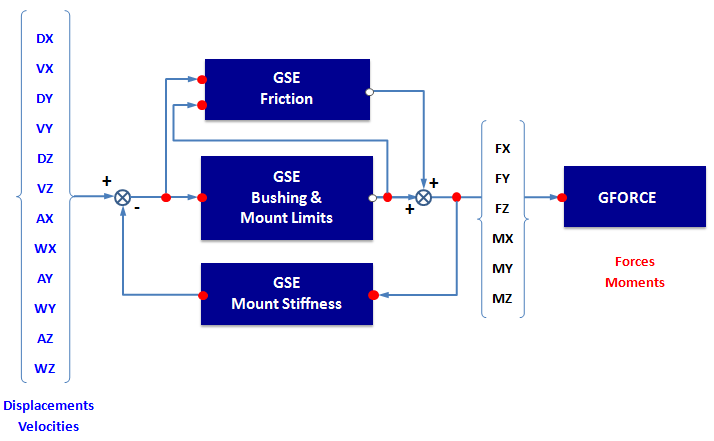Prior to running an analysis, you have to define the parameters governing the behavior of the bushing, and you have to select a bushing property file. During the analysis the parameters do not vary. All of the parameters that you can define are listed in the table below. Note: All of these are optional except PROPERTY_FILE.
[A] = angle dimension, [F] = force, [L] = length, [T] = time
Parameter
|
Type
|
Units
|
Entity
|
Description
|
PROPERTY_FILE
|
String
|
NA
|
GSE-Bushing
|
The name and path of the .gbs that specifies the stiffness and damping data for the bushing.
|
OFFSET_TRA
|
Array: 3 real values
|
[L]
|
GSE-Bushing
|
Translational displacement offsets for the bushing.
|
OFFSET_ROT
|
Array: 3 real values
|
[A]
|
GSE-Bushing
|
Rotational displacement offsets for the bushing.
|
PRELOAD_TRA
|
Array: 3 real values
|
[F]
|
GSE-Bushing
|
Force offsets for the bushing.
|
PRELOAD_ROT
|
Array: 3 real values
|
[F][L]
|
GSE-Bushing
|
Torque offsets for the bushing.
|
SCALE_DISP
|
Array: 3 real values > 0
|
None
|
GSE-Bushing
|
Scales the {x, y, z} translational displacement inputs to the bushing.
|
SCALE_RDISP
|
Array: 3 real values > 0
|
None
|
GSE-Bushing
|
Scales the {rx, ry, rz} rotational displacement inputs to the bushing.
|
SCALE_FORCE
|
Array: 3 real values > 0
|
None
|
GSE-Bushing
|
Scales the bushing force {fx, fy, fz} outputs.
|
SCALE_TORQUE
|
Array: 3 real values > 0
|
None
|
GSE-Bushing
|
Scales the bushing torque {tx, ty, tz} outputs.
|
LOCAL_STIFFNESS_ACT
|
Array: 6 int values
|
None
|
Mount
|
Switches the local stiffness: ON=1, OFF=0 for the X, Y, Z, RX, RY, RZ directions. For example {1,0,0,0,0,0} turns local stiffness on in the X direction, while all other directions are off (rigid).
|
LOCAL_STIFFNESS_TRA
|
Array: 3 real values ≥ 0
|
[F][L]
|
Mount
|
Combined local translational stiffness of I-Body and J-Body in the X, Y, Z directions.
|
LOCAL_STIFFNESS_ROT
|
Array: 3 real values ≥ 0
|
[F][L]
|
Mount
|
Combined rotational stiffness of I-Body and J-Body in the X, Y, Z directions.
|
LOCAL_DAMPING_TRA
|
Array: 3 real values ≥ 0
|
[F][T][L -1]
|
Mount
|
Combined local translational damping of the I-Body and J-Body in the X, Y, Z directions.
|
LOCAL_DAMPING_ROT
|
Array: 3 real values ≥ 0
|
[F][L][T][A] -1
|
Mount
|
Combined local rotational damping of the I-Body and J-Body about the X,Y,Z directions.
|
LOCAL_STIFFNESS_FLAG
|
Enumeration:
always_on
always_off
rigidbody_only
|
No Units
|
Mount
|
Switches local stiffness on and off:
always_on = stiffness is active.
always_off = stiffness is inactive.
rigidbody_only = stiffness is active when the I-Body and J-Body are both rigid-bodies.
|
|








